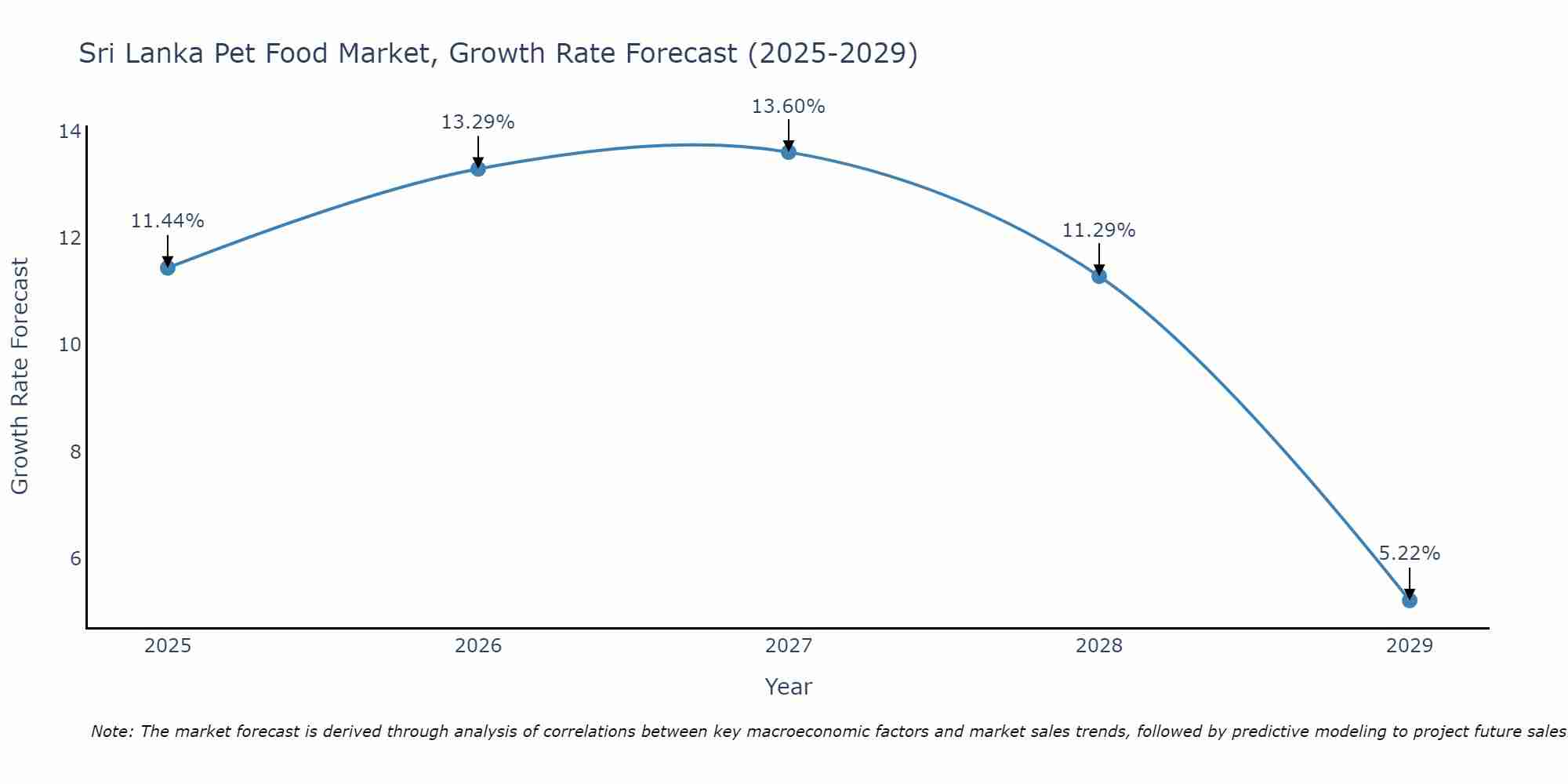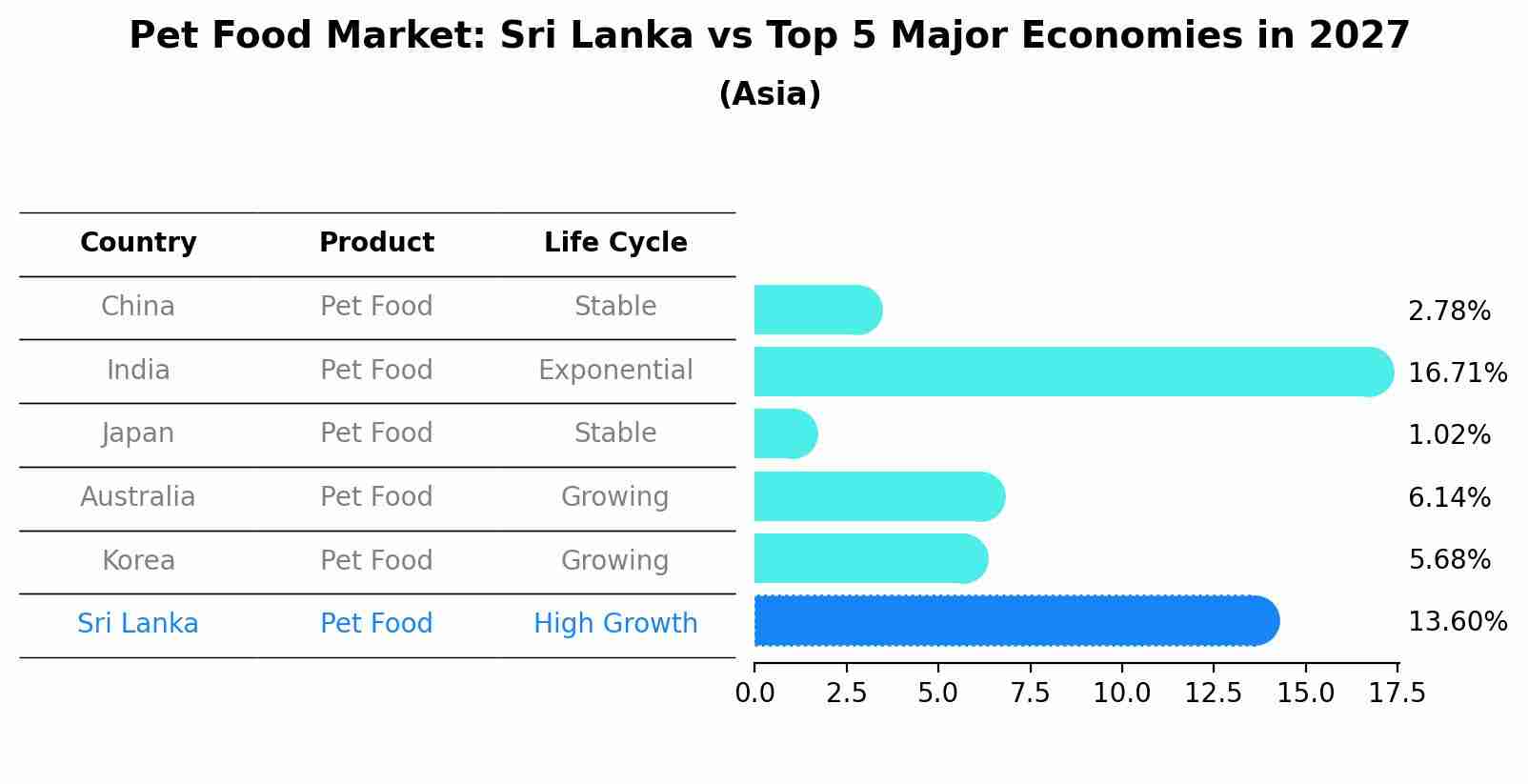Sri Lanka Pet Food Market (2025-2031) Outlook | Size, Share, Forecast, Companies, Analysis, Revenue, Industry, Growth, Trends & Value
| Product Code: ETC383911 | Publication Date: Aug 2022 | Updated Date: Jul 2025 | Product Type: Market Research Report | |
| Publisher: 6Wresearch | Author: Shubham Padhi | No. of Pages: 75 | No. of Figures: 35 | No. of Tables: 20 |
Sri Lanka Pet Food Market Size Growth Rate
The Sri Lanka Pet Food Market is projected to witness mixed growth rate patterns during 2025 to 2029. The growth rate begins at 11.44% in 2025, climbs to a high of 13.60% in 2027, and moderates to 5.22% by 2029.

Pet Food Market: Sri Lanka vs Top 5 Major Economies in 2027 (Asia)
By 2027, Sri Lanka's Pet Food market is forecasted to achieve a high growth rate of 13.60%, with China leading the Asia region, followed by India, Japan, Australia and South Korea.

Sri Lanka Pet Food Market Synopsis
The Sri Lanka pet food market is experiencing steady growth driven by increasing pet ownership, rising disposable incomes, and changing consumer preferences towards premium and specialized pet food products. The market is primarily dominated by dog and cat food segments, with a growing trend towards natural and organic pet food options. Key players in the market are focusing on product innovation, quality, and packaging to cater to the evolving demands of pet owners. Distribution channels such as pet stores, supermarkets, and online retailers are playing a crucial role in expanding the market reach. The market is expected to witness further growth with the rising awareness about pet health and nutrition, urbanization, and the humanization of pets driving the demand for high-quality pet food products.
Sri Lanka Pet Food Market Trends
In the Sri Lankan pet food market, a notable trend is the increasing demand for natural and organic pet food products. Pet owners are becoming more conscious of the ingredients in their pet`s food, opting for products that are free from artificial additives, preservatives, and colors. This trend is driven by the growing awareness of the health benefits of natural ingredients for pets, as well as the desire to provide their furry companions with high-quality nutrition. Additionally, there is a rising interest in specialized diets such as grain-free, gluten-free, and hypoallergenic options to cater to pets with specific dietary needs or sensitivities. Manufacturers are responding to these trends by introducing a wider range of natural and specialty pet food products to meet the evolving preferences of consumers in the Sri Lankan market.
Sri Lanka Pet Food Market Challenges
In the Sri Lanka Pet Food Market, challenges include limited consumer awareness about the benefits of commercial pet food compared to homemade alternatives, leading to a preference for traditional feeding practices. Distribution and logistical challenges also exist, with a lack of widespread availability of premium pet food brands outside of major cities. Import regulations and tariffs can increase the cost of imported pet food, affecting affordability for some consumers. Additionally, the market faces competition from lower-priced and counterfeit products, which can undermine the reputation of established brands. Overall, education campaigns, improved distribution networks, and efforts to combat counterfeit products are necessary to overcome these challenges and stimulate growth in the Sri Lanka Pet Food Market.
Sri Lanka Pet Food Market Investment Opportunities
The Sri Lanka pet food market presents interesting investment opportunities due to the growing pet ownership rates in the country, coupled with an increasing awareness about pet health and nutrition. With the rising disposable income levels and urbanization, more Sri Lankans are opting to keep pets, driving the demand for high-quality pet food products. Investing in premium and specialized pet food segments, such as natural, organic, or breed-specific foods, could be a lucrative opportunity in this market. Additionally, there is potential for innovation in packaging, flavors, and formulations to cater to the diverse preferences of pet owners. Partnering with local distributors and retailers, as well as leveraging digital marketing channels to reach a wider audience, can help capitalize on the evolving pet food market trends in Sri Lanka.
Jordan Agar Market Government Policies
The Sri Lankan government has implemented policies to regulate the pet food market to ensure the safety and well-being of pets. These policies include setting standards for ingredients used in pet food, labeling requirements for transparency, and quality control measures to prevent contamination. Additionally, the government has imposed import regulations to monitor the entry of foreign pet food products into the market. These regulations aim to protect consumers and pets from substandard or harmful products while also promoting the growth of the local pet food industry. Adherence to these policies is essential for pet food manufacturers and importers to operate in compliance with Sri Lankan law and contribute to a thriving and responsible pet food market in the country.
Sri Lanka Pet Food Market Future Outlook
The Sri Lanka pet food market is poised for steady growth in the coming years driven by factors such as rising pet ownership rates, increasing disposable income, and a growing awareness of pet health and nutrition. As more Sri Lankans view their pets as integral members of the family, the demand for high-quality pet food products is expected to rise. The market is likely to see a shift towards premium and natural pet food options, with a focus on ingredients that promote overall health and well-being for pets. Additionally, the convenience of packaged pet food and the expansion of online retail channels are projected to further boost market growth. Overall, the future outlook for the Sri Lanka pet food market appears promising with opportunities for both domestic and international pet food brands to cater to the evolving needs of pet owners.
Key Highlights of the Report:
- Sri Lanka Pet Food Market Outlook
- Market Size of Sri Lanka Pet Food Market, 2024
- Forecast of Sri Lanka Pet Food Market, 2031
- Historical Data and Forecast of Sri Lanka Pet Food Revenues & Volume for the Period 2021 - 2031
- Sri Lanka Pet Food Market Trend Evolution
- Sri Lanka Pet Food Market Drivers and Challenges
- Sri Lanka Pet Food Price Trends
- Sri Lanka Pet Food Porter's Five Forces
- Sri Lanka Pet Food Industry Life Cycle
- Historical Data and Forecast of Sri Lanka Pet Food Market Revenues & Volume By Type for the Period 2021 - 2031
- Historical Data and Forecast of Sri Lanka Pet Food Market Revenues & Volume By Dry Food for the Period 2021 - 2031
- Historical Data and Forecast of Sri Lanka Pet Food Market Revenues & Volume By Wet Food for the Period 2021 - 2031
- Historical Data and Forecast of Sri Lanka Pet Food Market Revenues & Volume By Snacks/Treats for the Period 2021 - 2031
- Historical Data and Forecast of Sri Lanka Pet Food Market Revenues & Volume By Animal for the Period 2021 - 2031
- Historical Data and Forecast of Sri Lanka Pet Food Market Revenues & Volume By Dog for the Period 2021 - 2031
- Historical Data and Forecast of Sri Lanka Pet Food Market Revenues & Volume By Cat for the Period 2021 - 2031
- Historical Data and Forecast of Sri Lanka Pet Food Market Revenues & Volume By Others for the Period 2021 - 2031
- Sri Lanka Pet Food Import Export Trade Statistics
- Market Opportunity Assessment By Type
- Market Opportunity Assessment By Animal
- Sri Lanka Pet Food Top Companies Market Share
- Sri Lanka Pet Food Competitive Benchmarking By Technical and Operational Parameters
- Sri Lanka Pet Food Company Profiles
- Sri Lanka Pet Food Key Strategic Recommendations
Frequently Asked Questions About the Market Study (FAQs):
- Single User License$ 1,995
- Department License$ 2,400
- Site License$ 3,120
- Global License$ 3,795
Search
Related Reports
- Uganda Precast and Aggregate Market (2025-2031) | Strategy, Consumer Insights, Analysis, Investment Trends, Opportunities, Growth, Size, Share, Industry, Revenue, Segments, Value, Segmentation, Supply, Forecast, Restraints, Outlook, Competition, Drivers, Trends, Demand, Pricing Analysis, Competitive, Strategic Insights, Companies, Challenges
- Australia IT Asset Disposal Market (2025-2031) | Strategy, Consumer Insights, Analysis, Investment Trends, Opportunities, Growth, Size, Share, Industry, Revenue, Segments, Value, Segmentation, Supply, Forecast, Restraints, Outlook, Competition, Drivers, Trends, Demand, Pricing Analysis, Competitive, Strategic Insights, Companies, Challenges
- UAE Building Thermal Insulation Market Outlook (2025-2031) | Revenue, Companies, Share, Trends, Growth, Size, Forecast, Industry, Analysis & Value
- Portugal Electronic Document Management Market (2025-2031) | Strategy, Consumer Insights, Analysis, Investment Trends, Opportunities, Growth, Size, Share, Industry, Revenue, Segments, Value, Segmentation, Supply, Forecast, Restraints, Outlook, Competition, Drivers, Trends, Demand, Pricing Analysis, Competitive, Strategic Insights, Companies, Challenges
- France Electronic Document Management Market (2025-2031) | Strategy, Consumer Insights, Analysis, Investment Trends, Opportunities, Growth, Size, Share, Industry, Revenue, Segments, Value, Segmentation, Supply, Forecast, Restraints, Outlook, Competition, Drivers, Trends, Demand, Pricing Analysis, Competitive, Strategic Insights, Companies, Challenges
- Portugal Occupational Health & Safety Services Market (2025-2031) | Strategy, Consumer Insights, Analysis, Investment Trends, Opportunities, Growth, Size, Share, Industry, Revenue, Segments, Value, Segmentation, Supply, Forecast, Restraints, Outlook, Competition, Drivers, Trends, Demand, Pricing Analysis, Competitive, Strategic Insights, Companies, Challenges
- Netherlands Occupational Health and Safety Services Market (2025-2031) | Strategy, Consumer Insights, Analysis, Investment Trends, Opportunities, Growth, Size, Share, Industry, Revenue, Segments, Value, Segmentation, Supply, Forecast, Restraints, Outlook, Competition, Drivers, Trends, Demand, Pricing Analysis, Competitive, Strategic Insights, Companies, Challenges
- Belgium and Luxembourg Facility Management Market (2025-2031) | Strategy, Consumer Insights, Analysis, Investment Trends, Opportunities, Growth, Size, Share, Industry, Revenue, Segments, Value, Segmentation, Supply, Forecast, Restraints, Outlook, Competition, Drivers, Trends, Demand, Pricing Analysis, Competitive, Strategic Insights, Companies, Challenges
- Russia Women Intimate Apparel Market (2025-2031) | Strategy, Consumer Insights, Analysis, Investment Trends, Opportunities, Growth, Size, Share, Industry, Revenue, Segments, Value, Segmentation, Supply, Forecast, Restraints, Outlook, Competition, Drivers, Trends, Demand, Pricing Analysis, Competitive, Strategic Insights, Companies, Challenges
- Africa Chocolate Market (2025-2031) | Size, Share, Trends, Growth, Revenue, Analysis, Forecast, industry & Outlook
Industry Events and Analyst Meet
Our Clients
Whitepaper
- Middle East & Africa Commercial Security Market Click here to view more.
- Middle East & Africa Fire Safety Systems & Equipment Market Click here to view more.
- GCC Drone Market Click here to view more.
- Middle East Lighting Fixture Market Click here to view more.
- GCC Physical & Perimeter Security Market Click here to view more.
6WResearch In News
- Doha a strategic location for EV manufacturing hub: IPA Qatar
- Demand for luxury TVs surging in the GCC, says Samsung
- Empowering Growth: The Thriving Journey of Bangladesh’s Cable Industry
- Demand for luxury TVs surging in the GCC, says Samsung
- Video call with a traditional healer? Once unthinkable, it’s now common in South Africa
- Intelligent Buildings To Smooth GCC’s Path To Net Zero













